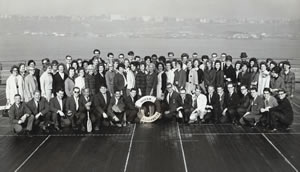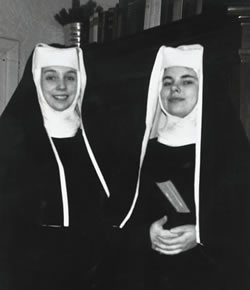 |
 |
 |
||||
 |
|
Movie Makers in Mozart’s Town
From 1958 through 1964, the Oberlin Conservatory experimented with a unique program, transferring its entire junior class to Austria for a year of study at the University Mozarteum. For me, the Oberlin-in-Salzburg program was a year of musical and cultural journeys. While leafing through my scrapbook of post-cards, 1964 recital programs, and photos of friends, I often pause at the creased page bearing a treasured snapshot. It’s me—wearing a nun’s habit and smiling for the camera— a tangible reminder of my experience as a movie extra in The Sound of Music. Despite having seen the film repeatedly over the past 39 years, I still find myself searching through the sea of faces hidden behind black habits. We nuns appear in the von Trapp wedding scene, singing (actually mouthing) the words to How Do You Solve the Problem of Maria? I’m standing with three other Conser-vatory students, positioned in the second row, third from the right. Salzburg was a provincial town in the 1960s. Bicyclists and pedestrians filled its narrow sidewalks, and many Salzburgers dressed in traditional Austrian attire, making it the ideal setting for American moviemakers emulating a 1930s pre-war city. I lived in Hotel Steinlechner, a short streetcar ride to the center of Mozart’s town. While walking to my classes in fine arts and history, I’d pass by churches and fountains—an education in itself. Across from the Salzach River was the Mozarteum, the second home to Oberlin students. On this particular April afternoon, I lingered in front of the school, taking in the fairy-tale city encircled by high mountain peaks. My friends began calling to me, interrupting my daydreaming: “They need movie extras who can sing!” they yelled. I followed them inside to a crowded rehearsal room in the vocal studio. There, sitting confidently in the front row, we began to sight read the music and its wily lyrics about someone named Maria. Our Oberlin-trained voices rang out clearly, as did our unmistakable American accents. Little did we realize that other voices—authentic Austrian voices—had already been recorded for the song; these agents were merely looking for bodies.
Our efforts were not in vain. My friends and I each received a typewritten note with the message “BE PUNCTUAL” and an address to the Mondsee Cathedral. At 4:00 the next morning, we became subjected to the intimate details of a nun’s attire. The garment was bulky and inflexible, and the movie makeup was macabre, drying like plastic on our faces and discouraging any animated conversation. The final touch was a veil with a white, starched, penguin-like collar. An hour later, we flocked somberly into the cathedral. I watched a photographer focus his camera on the wedding processional as the bride moved regally down the aisle. The pipe organ boomed forth the chords of Wagner’s Wedding March, a forceful sound prop in this 15th-century Gothic cathedral. Lights cascaded across the walls, illuminating the granite columns and casting dancing shadows. The sight was exhilarating, but it shattered quickly when a voice called “Cut!” as men shouted directions across the aisles. All morning, our congregation of nuns stood patiently on the sidelines. Moviemaking is tedious, repetitious, and not at all romantic. What kept our interest was Julie Andrews, playing the part of Maria, the bride. Her vocal warm-ups were impressive: she lifted her voice in two octave arpeggios with a clear, resonant sound. For us, it was a free vocal lesson. Ms. Andrews made the most of the continuous delays. “I will not do this scene again. This is the last time,” she called out in her clipped British accent, rolling her eyes in protest toward the vaulted ceiling. The familiar rumble of equipment shattered the sanctuary. “Be ready for action in five minutes,” called a voice from a back pew. “Will this really be the last time?” I asked, glancing at Peggy Wood, the older American actress playing the Mother Abbess. Although we were all uncomfortable in our heavy attire, she was wilting before my eyes. Instinctively, I stood in front of her, shielding her from one per- sistent ray of light. She nodded her approval as I shyly looked her way. It was late afternoon when we were finally summoned to the wrought iron gate and shuffled in place according to height. The long day had taken its toll. Afterwards, in the square, we met shoppers who bowed to us as we rushed toward the dressing rooms. Enough of this movie business! I just wanted to be a student again. These days, at parties, I am often escorted to the piano to play Richard Rodgers’ songs, or I become the surrogate “singing nun.” Everyone is convinced that they have seen me in the film! But did we Obies get a movie credit? Hardly! We each received $10 in cash for a 14-hour-day. The much better reward was knowing we had contributed to one of the most famous films ever made. |

